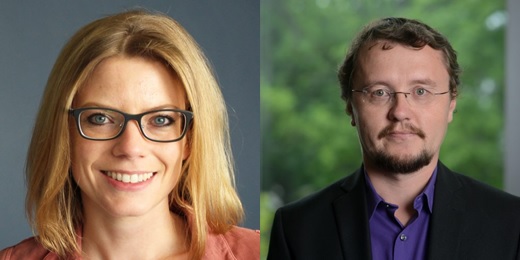
Congratulations to nuclear engineering faculty members, Dr. Katharina Stapelmann (PI) and Dr. Igor Bolotnov (co-PI)! NSF will fund their project entitled “Plasma Breakdown and Instabilities in the Multiphase Plasma-Gas Bubble-Liquid System”.
This collaborative research project will study the interaction of air bubbles in water with atmospheric pressure plasma – the fourth state of matter, composed of neutral atoms and molecules, charged ions and electrons, and a variety of reactive species. Gas/liquid systems with steep property changes consisting of plasma, gas, and liquid have incredible promise for various fields of applications ranging from water cleaning to agriculture applications and plasma-activated liquids for medical use. Although much progress has been made in understanding plasma-liquid interactions – including the development of the first upscaled devices for the degradation of fluorinated organic compounds known as “forever molecules” – to date there have been only a few detailed investigations on plasma breakdown mechanisms in the multiphase plasma-bubble-liquid system. The multiphase system itself and the electrical breakdown mechanisms in such a system are not well understood, hampering the efficient use of plasma-bubble-liquid systems. Exploring the electrical breakdown mechanisms will benefit the plasma-liquid research society, leading to new emerging applications to solve problems like groundwater contamination, bacterial contamination of hospital wastewater, providing fertilizer on-farm and reducing the amount of water needed for irrigation in times where water is becoming increasingly precious.
Although extensive research has been performed on plasma-liquid interactions, this multidisciplinary topic still challenges the scientific community. The introduction of gas bubbles is of great interest because it opens another degree of freedom in this multiphase system that influences the plasma behavior. Furthermore, bubbles are ubiquitous in liquids, and additional bubbles can be produced throughout the liquid by energy transport at the plasma-liquid interface. Thus, the behavior of bubbles and the impact of bubbles on the formation of plasma are of great interest for the whole plasma-liquid scientific community. This project addresses the critical need for developing a fundamental quantitative understanding of the bubble – from bubble formation, the interaction of the gas bubbles with the electric field, plasma interaction, to its impact on the electrical breakdown by combining multiphase modeling and experiments. Interface instabilities after electrical breakdown have been observed in previous research, but no fundamental explanation for this behavior could yet be determined. The multiphase plasma-bubble-liquid simulation will comprehensively address this complex system. We explore the electrical breakdown in the multiphase plasma-bubble-liquid system, correlate the bubble properties to electrical breakdown conditions, and explore the gas/liquid interface instabilities after electrical breakdown. The combination of experiments and simulation enables us to gain fundamental understanding of the breakdown and instabilities in the multiphase plasma-bubble-liquid system.